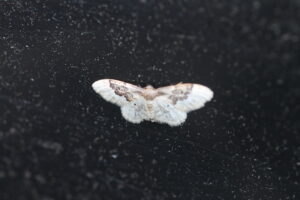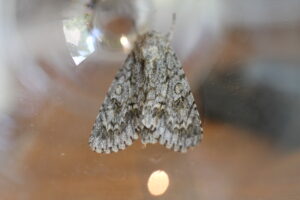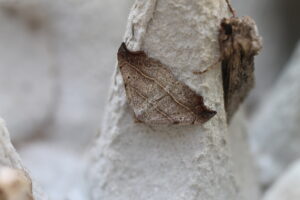24 July 2025
The Colonizers of Yorkshire
Each summer, the mothscape over Yorkshire shifts in subtle ways. Some of these changes are down to better luck or keener eyes, but others hint at something larger: the quiet, ongoing reshaping of our ecosystems. As temperatures rise, many moth species once confined to southern England are steadily making their way north. It’s not just an occasional wanderer anymore, some of these newcomers are here to stay.
As we sit down to identify species, Patrick will often reference the findings of traps he’s set in the past. The major differences he’s noticed between the catches of different summers recently sent me down a research rabbit-hole.
Between 1995 and 2016, the northern limit of species distributions in Britain shifted northwards at an average rate of 5 km per year. In that time, 71% of 487 larger moth species assessed spread further north, according to the National Moth Recording Scheme. That shift is reshaping what we see in the trap here in Yorkshire. Each year now seems to bring species that were once rare or even unrecorded in the county, and often, they appear in growing numbers. The guests in our latest trap illustrated this migration quite beautifully. Below are three southern species that are increasingly claiming Yorkshire as home.

Least Carpet (Idaea rusticata)
Patrick first spotted one of these beauties while trapping in Luddington-in-the-Brook ten years ago, and his hope that one would finally show up at Shandy Hall came true this summer. This small, pale, delicately marked moth was once restricted to southeastern England. First recorded in London in 1831, it stayed close to its roots for over a century. Then, from the 1950s onward, it launched one of the most dramatic expansions in British moth history. Between 1968 and 2002, it increased in abundance by a staggering 41,000%—the largest population expansion recorded in the Rothamsted Insect Survey (RIS) data.
Yorkshire first welcomed Idaea rusticata in 2006, and though it has had some stop-start years, the last few seasons have marked a real turning point with rising numbers . It still holds “local” status in Yorkshire, but that’s changing quickly. It’s a textbook case of climate-driven colonisation: a southern species finding northern ground increasingly to its liking.
The genus name Idaea refers to Mount Ida in Greek mythology, a place rich in biodiversity and natural wonder, while rusticata comes from Latin, meaning “of the countryside” or “rural,” likely referencing its subtly earthy colours and habitat.

Sycamore (Acronicta aceris)
Not technically found in our trap this time, but worth a mention because we did find one a few days later. Patrick found it around the house, and after a bit of confusion that led to a back-and-forth with Dr. Fletcher, we confirmed it was a new species for us. A. aceris is commonly mistaken for the Poplar Grey due to the striking similarity of their forewings. The hindwings, in contrast, are plain white. The wings of the Sycamore spread out were an interesting sight for me, it looks as if Mother Nature gave up halfway through painting.
The Sycamore moth was named by Linnaeus in 1758 (which explains the “acris” part of the name, a nod to its food plants like sycamore and maple), but it wasn’t reliably recorded in Yorkshire until 1992. Early sightings in the 1990s were scattered and inconclusive, and it wasn’t until the early 2000s that it began to establish a clearer presence. From there, its range expanded in bursts.
Today it’s part of a growing group of species that can now be found in gardens across the central, southern, and eastern parts of Yorkshire. This gave us hope of spotting one of its spectacular caterpillars, with its tufts of yellow-orange hairs and white-backed blotches. Bright though it may be, it’s not dangerous, though it can cause minor skin irritation if handled. With sycamores growing readily around Shandy Hall, it may have been here longer than we realised, just missed or mistaken. But not anymore.

Beautiful Hook-tip (Laspeyria flexula)
There was a time when this moth was limited to just two known sites in Yorkshire, Scarborough and York, and then it disappeared altogether. For decades, a Beautiful Hook-tip sighting was quite the unusual event. But starting around 2007, it returned in force. By 2020, it had established itself solidly across most of the county, and even counts in the double digits were becoming common.
Laspeyria flexula is a lichen-feeding species with subtle curves to its forewings, which give it the characteristic “hook-tip” shape. The genus name Laspeyria is thought to honour the 18th-century German entomologist J. H. Laspeyres or may derive from a misspelling of his name. The species name flexula comes from Latin, meaning “slightly bent” or “curved”, a nod to the distinctive shape of its wings.
The RIS data for this beauty tells quite the story. As its range crept north, 2023 marked the first slight drop in numbers, a possible sign that parasitoids or environmental limits are catching up. But with over 800 individuals recorded across 150+ sites in both 2023 and 2024, it’s safe to say this species is now a regular part of our summer mothscape.
The Most Common Guests in this Trap
While the species above highlight dramatic shifts, the rest of our trap results paint a more familiar but no less fascinating picture of summer life here:
- Broad-bordered Yellow Underwing (Noctua fimbriata) – 100 counted
- Wainscots (mostly Mythimna pallens and Mythimna impura) – 30 counted
- Common Footman (Eilema lurideola) – 60 counted
- Dark Arches (Apamea monoglypha) – 30 counted
Many of these have shown steady numbers year over year, but what’s changing is the company they keep. Southern arrivals are no longer one-off sightings. As the climate shifts, so too does the mothscape, flickering and reforming in response. As we keep our traps lit, we’ll keep watching where it heads next.
Post by Sophia Hernandez (UPenn intern)
Recent Moths
- Rise of the AI Naturalist
- Best Moths for a Haunted Abbey
- The Real and Fake Deaths of Moths
- The Colonizers of Yorkshire
- Glamour in the Dark: Two Newcomers Arrive at Shandy Hall
- 25 July 2023 – Collective Noun for Hawkmoths
- MOTH LIST to August 2023 with links
- 28 July 2023 – TRIPLE New Species Alert!
- 18 July 2023 – A Golden…Plusia!
- 13 July 2023 – Arts and Sciences
- 10 July 2023 – Rise of the Yellow Underwings
- 4 July 2023 – Cold-weather Catch






